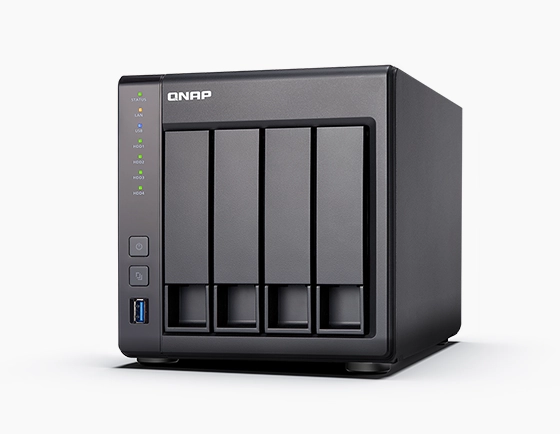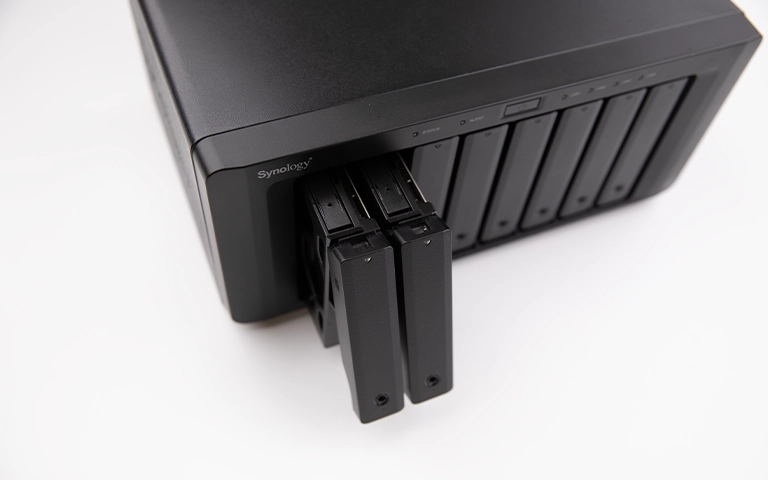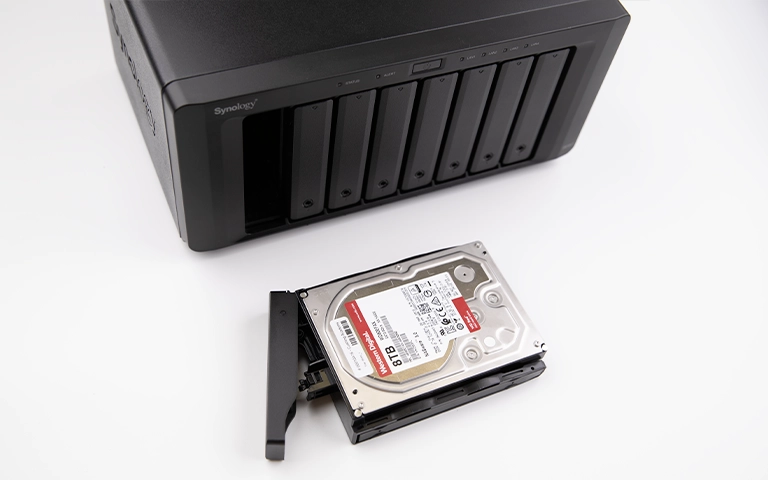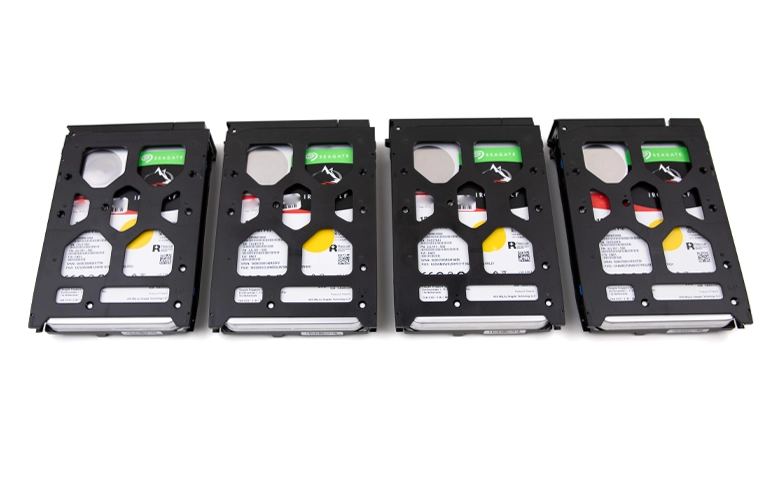If you have been looking into NAS storage, chances are you have come across QNAP and Synology. They are the two big names everyone talks about, and for good reason. Both provide dependable ways to store, protect, and share your files. The tricky part is figuring out which one fits you best.
That is where this guide comes in. We will walk through the real differences between QNAP and Synology, from day-to-day usability to performance and reliability. By the end, you will have a clear picture of what each system brings to the table. And if you ever run into unexpected issues such as drive failures or data loss, our team at RAID Recovery Services is always ready to help.

Why QNAP and Synology Dominate the NAS Market
QNAP and Synology have earned their place at the top of the NAS industry by consistently delivering systems that people trust. Both brands combine reliable performance with flexibility, making them the first choice for businesses and home users alike.
What sets them apart is how much they have expanded the role of a NAS. These devices now go far beyond basic file storage. With either brand, you can run applications, automate backups, and even create your own private cloud.
Their continued focus on innovation and usability has kept them ahead of smaller competitors. That is why the QNAP vs Synology debate is almost always the starting point for anyone serious about choosing a NAS.
Key reasons they dominate the market:
Proven track record of reliability
Expanding NAS functionality beyond storage
User-friendly ecosystems with apps and cloud options
Ongoing innovation and software updates

Ease of Use and Setup
The first thing most people notice about a NAS is how easy or complex the setup feels. This can make a big difference in whether the system feels comfortable from day one or requires more time to learn.
Synology is designed with simplicity in mind. Its DiskStation Manager (DSM) interface is clean and intuitive, guiding you through tasks like creating shared folders, adding users, and setting up backups without unnecessary steps. Even if you are new to NAS systems, the process feels straightforward and approachable.
QNAP takes a different path by offering more control. The QTS interface is packed with features and customisation options, which advanced users value. For newcomers it can feel a bit overwhelming at first, but for those who want to fine-tune their system, the extra flexibility makes QNAP an appealing choice.
Performance and Hardware Options
Performance is one of the biggest deciding factors when choosing between QNAP and Synology. Both deliver reliable systems, but their approach to hardware is very different.
QNAP often emphasises raw power. Many of its models come with faster processors, higher memory capacity, and broader connectivity options. Features such as multiple LAN ports or HDMI outputs make it a strong choice for those running heavy applications, virtual machines, or multimedia setups.
Synology focuses more on balance and efficiency. While its specifications may not always match QNAP’s top-end hardware, Synology systems are carefully optimised to work seamlessly with their software. This integration results in stable, consistent performance that suits users who value reliability over maximum power.
At a glance:

Software and Features
Synology DSM
Synology’s strength lies in its DiskStation Manager (DSM). The interface is polished, stable, and designed with ease of use in mind. It includes built-in apps for file sharing, backups, cloud synchronisation, and media streaming. Everything feels streamlined, making it simple for beginners yet reliable enough for business environments.
QNAP QTS
QNAP’s QTS software takes a different approach. It offers a wide range of apps and greater flexibility, letting users run virtual machines, manage containers, and install more third-party tools. This makes it attractive for power users and companies that need their NAS to go beyond basic storage. While the interface can feel busier, it opens the door to more advanced customisation.
Highlights at a glance:
Synology DSM: polished interface, stable apps, simple workflows
QNAP QTS: extensive app library, advanced customization, strong virtualization support
Fast turnaround times for business-critical data
Security and Reliability
Security is one of the biggest concerns when choosing a NAS, and both QNAP and Synology put a strong focus on protecting data.
Synology leans on stability and safe defaults. Features such as two-factor authentication, firewall tools, and automatic updates are built into DSM, giving users dependable protection without extra setup. Frequent patches further strengthen its reputation for reliability.
QNAP takes a more flexible approach. It offers advanced tools such as snapshot protection, antivirus integration, and customisable access controls. While this requires more involvement from the user, it gives businesses and power users tighter control over how their systems are secured.
Key takeaways:
Synology: secure by default, dependable updates, trusted stability
QNAP: advanced tools, more customization, greater control for administrators

Business vs Home Use Cases
QNAP and Synology can both serve businesses and home users, but their strengths stand out differently depending on how you plan to use them.
For Business
QNAP’s stronger hardware and advanced software options make it ideal for running multiple applications at once.
Features such as virtualisation, container management, and broad connectivity support professional environments.
Administrators who want deeper control over settings often prefer QNAP.
For Home
Synology’s simplicity and polished interface make it a better fit for households.
Easy-to-use apps for media streaming, backups, and personal cloud storage keep it approachable.
Stable updates and reliable security features reduce the need for hands-on management.
In practice, QNAP often appeals to companies and tech-savvy users, while Synology is the go-to choice for families and individuals who value ease of use.
When Problems Arise: Data Recovery Considerations
Even with the most reliable NAS systems, problems can still occur. Hard drives wear out, power surges cause failures, and software errors sometimes lead to corrupted data. Both QNAP and Synology offer tools to help you recover from minor issues, but these built-in options are limited.
DIY recovery attempts carry risks. Rebuilding an array incorrectly or continuing to use a failing drive can make the situation worse. That is why many businesses and home users turn to professionals when the data on their NAS becomes inaccessible.
At RAID Recovery Services, we specialise in handling these complex cases. Whether it is a failed RAID array in a business server or a damaged NAS used for home storage, our engineers have the tools and experience to recover critical data safely.
Key reminder:
Built-in recovery tools are limited
DIY fixes can increase the risk of permanent loss
Professional recovery ensures data is handled safely and securely
Trust the experts with proven results
Final Thoughts: Making the Right Choice
Both QNAP and Synology are excellent NAS solutions, but the right choice depends on what you value most. If you want raw power, advanced customisation, and a system that can handle demanding workloads, QNAP is a strong option. If you prefer simplicity, reliability, and software that feels seamless, Synology may be the better fit.
No matter which brand you choose, remember that a NAS is only as safe as the data it holds. Drive failures and system errors can happen, often when you least expect them. When they do, RAID Recovery Services is here to help you recover quickly and securely, so your files remain protected.

Frequently Asked Questions
Which is better for beginners, QNAP or Synology?
Synology is generally better for beginners thanks to its clean interface and simple setup process. QNAP offers more advanced options, which can be overwhelming if you are new to NAS systems.
Is QNAP more secure than Synology?
Both brands take security seriously. Synology emphasises stability and safe defaults, while QNAP provides more advanced tools for users who want extra control. The best choice depends on whether you prefer simplicity or customisation.
Do QNAP and Synology both support RAID configurations?
Yes, both brands support multiple RAID levels. This lets you improve performance, add redundancy, or expand storage depending on your needs. The exact RAID options vary by model.
Can I switch from Synology to QNAP without losing data?
It is possible to move from one system to the other, but the process can be complex. Always back up your files first, and if you are working with RAID arrays, consider professional help to avoid data loss.